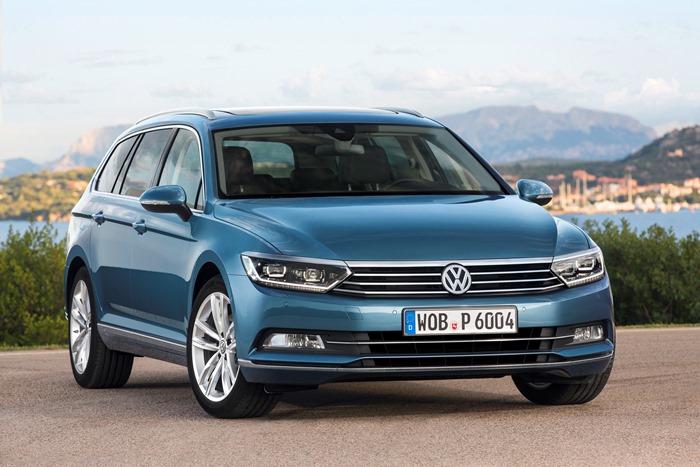
Car reviews
Read our expert car reviews - where we give insight into the latest vehicles to hit our roads.
06 May 2015
On the road, the 2015 Volkswagen Passat is quiet and has a genuine executive car feel about it. We found the entry level 132kW petrol engine to be lively, free-revving and well matched to the 7 speed DSG ‘box, so it’s the one we’d like to live with.

The new Volkswagen Passat must provide Volkswagen with a few problems. Not because it’s a bad car; in fact it’s far from it, being one of the most stylish and refined in its segment. But here’s the problem; what is its segment?
For the past two or three years Volkswagen have placed a great deal of emphasis on telling us that their brand should no longer be considered “premium” and that they’ve gone mainstream and want to play in the volume sector. And they’ve done a fantastic job of that.
The Polo competes with the Suzuki Swift, The Golf with the Toyota Corolla and the Tiguan’s sharp entry price point places it beneath the RAV4. And of course, they’ve got the Amarok ute that plays in Ford Ranger and Toyota Hilux territory.
And now they bring us the new 8th generation Passat; an upper-medium sized sedan and wagon. Now, it’s no secret that buyers are leaping out of medium and large cars in their droves into SUVs. But there’s an exception to that rule, with premium medium cars such as the BMW 3 Series, Mercedes-Benz C Class and Audi A4 all performing well on the sales ladder.
Therefore, Volkswagen are quite happy for us to consider the Passat as premium. Sort of. At the recent Auckland based launch, European Motor Distributor’s boss Richard Giltrap made no bones about this being a challenging segment. But his enthusiasm for the Passat was clear to see.
"The Passat suits the New Zealand environment really well, and that it’s the sort of car that can tempt traditional Kiwi large car buyers away from their big sedans and wagons, particularly due to major improvements made to the internal combustion engine" he said.
By that, he’s talking about how forced induction four cylinder engines can match, or better large capacity performance, but are considerably more economical to run.
As someone who deals in some of the worlds most prestige and high ticket vehicle brands, he's hardly likely to want to bag the other products he deals with, but he made it clear he thinks the Passat can foot it with some considerable pricier vehicles. “I drive some expensive and impressive cars” he said, “but the Passat is the complete package. The design is impressive from every angle and it’s a lot of car for the money”.
So, that’s Mr Giltrap’s view – what’s ours?
Well, he’s right on the money really. There’s not much that separates the Passat from those prestige German brands, except for the price. Road presence, particularly front on, is particularly strong, with the overall styling being conservative but classy. Volkswagen claim it’s the “New Business Class”, and that’s a fair description. Maybe not quite First Class, but well and truly Business!
Cabin ambience is a big leap from that of its predecessor and it’s as comfortable, and more spacious than any of those afore-mentioned German competitors. Overall length remains about the same, but the wheelbase has been stretched a massive 79mm, giving 40mm extra rear seat leg room, and headroom is up by 30mm.
Power is up from 118kW to 132kW for the entry-level 1.8 litre petrol engine and fuel consumption is down 18% from 7.1L/100km to 5.8L/100km. Currently, there’s also a 176kW/500Nm 2.0L bi-turbo TDI diesel, with a 206kW/380Nm TSI petrol and 140kW/400 TDI to follow. All but the 132kW model are Euro6 emission compliant, with the entry level model being Euro5.
New for Volkswagen is the AdBlue exhaust treatment for diesel models, an additive that enables them to meet Euro6. However, like other brands that use such treatments, customers shouldn’t need to worry about topping up, as it’s done at service time.
Standard for all models is a rear view camera, front and rear parking sensors, rain sensing wipers, keyless start and Isofix child seat points. Standard for 176kW diesel is Active Cruise Control (ACC), Lane Assist, Side Assist and Rear Traffic Alert (Blind Spot Detection). These features can be optioned into other models as a Driver Assistance Package for $2,500.
Comfortline, Highline, R-Line grades are on offer in both sedan and wagon configurations with the 132kW TSI powerplant, and the 140kW diesel sedan and wagon variants can be had with Highline or R Line spec. R-Line Plus level is reserved for the 206kW petrol and 176Kw diesel.
Pricing starts at $45,750 for the 132kW Comfortline sedan, $49,990 for Highline sedan and $54,990 for R-Line sedan. Diesels start at $53,490 for the 140kW Highline and $58,490 for R-Line.
R-Line Plus models will be $67,740 for 176kW bi-TDI sedan and $68,740 for 206kW TSI. Wagons have a $1,250 premium for all models.
On the road, it’s quiet and has a genuine executive car feel about it. Strangely enough, while diesels usually offer a lot more punch, we found the petrol version more nimble, lighter and livelier on its feet and better suited to the 7 speed DSG ‘box, so it’s the one we’d prefer to live with.